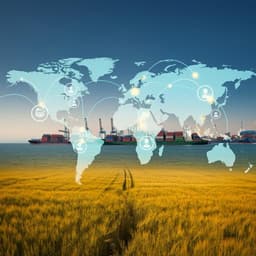
Economics
Global hake production and trade: Insights for food security and supply chain resilience
A. Ospina-alvarez, G. M. Aragão, et al.
Explore the intricate global hake trade network in this study, which identifies Spain as the key importer and Namibia and South Africa as chief exporters. The research, conducted by Andrés Ospina-Alvarez, Guilherme Martins Aragão, Lucía López-López, Sebastián Villasante, and Joan Moranta, highlights the growth in trade values and the need for resilience in trading practices for sustainable hake management.
~3 min • Beginner • English
Introduction
The paper investigates how global hake production and trade influence food security and supply chain resilience. It frames international food trade as a driver of nutrition, price stability, and economic development, while noting disparities in governance, infrastructure, and market access that leave low-income countries vulnerable to shocks. Hake (Merluccius and Urophycis) is positioned as a major whitefish commodity, accounting between 2016–2022 for 2.23% (by weight) and 2.19% (by value) of global frozen fish trade, second to species such as yellowfin tuna. The authors outline three objectives: (1) delineate the structure and characteristics of the global hake trade network (HGTN); (2) assess its resilience to ecological and economic shocks; and (3) explore how trade networks can be leveraged for sustainable fisheries management, equitable resource distribution, and enhanced global food security. The study situates this inquiry within the context of liberalized trade, traceability challenges, and the global decline of fish stocks within biologically sustainable levels, underscoring the need for resilient, adaptive trade systems.
Literature Review
The paper synthesizes work on global seafood trade networks and their vulnerabilities, including how liberalized trade complicates traceability and enforcement against IUU fishing, and the role of certification and ecolabels for consumer protection and sustainability. It references the decline in biologically sustainable fish stocks (from 90% in 1974 to 64.6% in 2019) and introduces network resilience concepts as critical for maintaining seafood supplies under shocks. Case studies of lobster and octopus trade networks show how market shifts and diversified commercial networks shape global outcomes, indicating that network position, not just volume, can drive influence. Prior methodological work supports using network analysis to uncover distant feedback loops and dependencies, informing policy and sustainable management. The review also contrasts regions with effective management (e.g., Argentine hake increases post-2017) against areas with overfishing (e.g., Mediterranean and Black Sea hake), highlighting management heterogeneity relevant to trade dynamics.
Methodology
The study proceeds in two parts. First, it analyzes global hake fishery production (1950–2020) using FAO FishStatJ global capture production data, tracing catches by species, continents, and subcontinents to identify trends and major producers. These data are integrated with UN Comtrade export and import statistics to estimate global per capita hake availability. Second, it focuses on the Global Hake Trade Network (HGTN) for 2016–2020, covering genera Merluccius and Urophycis, using UN Comtrade commodity codes 030366, 030378, and 030474 across 193 countries or territories.
To approximate national apparent food supply for hake (2016–2020), the authors compute: production + imports − exports, divided by human population. This FAO-inspired approach does not account for stock changes or non-food uses and may overestimate average consumption due to losses at various stages. Official databases lack detailed per-capita consumption for individual hake species, motivating this proxy.
Network analysis employs centrality measures: degree (and in-/out-degree), strength (weighted degree; in- and out-strength), betweenness (node and edge), and Page's Rank, to identify hubs, economic throughput, strategic intermediaries, and influential nodes. Hierarchical clustering (Ward’s method) groups traders by import and export links, with statistical significance evaluated via similarity profile method (permutations = 999, expected clusters = 1000). A Sankey diagram communicates the top 100 mass flows. Analyses are implemented in R (igraph v1.2.5, flashClust v1.01-2, ggplot2 v3.2.1, ggmap v3.0.0, ggraph v2.0.0, ggtree v3.0.2) and Python (Matplotlib, Seaborn). An interactive, spatially explicit web app provides maps, centrality measures, and downloadable processed data: https://mares-imedea.shinyapps.io/Hake_Global_Trade_Network/.
Key Findings
- Catches and species composition: Six of 22 hake species—Argentine (Merluccius hubbsi), Cape (M. capensis), North Pacific (M. productus), South Pacific (M. gayi), silver hake (M. bilinearis), and European hake (M. merluccius)—accounted for 94% of total catches (1950–2020). Peak catches occurred in the 1970s, reaching 23 million tonnes in 1973.
- Regional trends: European and South American fleets dominated until the late 1970s, after which South America (notably Argentina, Peru) led and continues to do so. European catches have declined since the early 1990s; Spain recorded the highest European catches. In Africa, hake catches increased since the 1950s, surged with Namibia’s rise around 1990, dipped mid-2000s, then stabilized, surpassing Europe; South Africa and Namibia together accounted for 21% of Africa’s catches (2016–2020). Asia and Oceania show fluctuating patterns, with Japan and later the Republic of Korea leading in Asia, and New Zealand in Oceania.
- Trade by region (2016–2020): Europe is the dominant net importer; Africa and North America are predominantly export-oriented; Asia is relatively balanced; South America shows low and comparable exports and imports.
- GDP, betweenness, and supply: Countries with higher GDP tend to have greater hake supply (linear model: GDP ~ food supply, adjusted R² = 0.24, p < 0.001) and higher network intermediation (GDP ~ betweenness, adjusted R² = 0.58, p < 0.001). Spain exhibits high betweenness and supply exceeding domestic catches since 1990, supported by imports. USA and China have high GDP but moderate normalized betweenness; Namibia and Argentina export with food supply below catches.
- Transaction dynamics: Total hake transactions increased in volume and value but growth rates declined after 2016. Volumes/values reported: 2016 = 319 tonnes and USD 908 million; 2017 = 469 tonnes (+47%) and USD 1.21 billion (+33%); 2018 = 497 tonnes (+5%) and USD 1.34 billion (+11%); 2019 = 499 tonnes (+0.3%) and USD 1.32 billion (slight decline); 2020 = 429 tonnes and USD 1.18 billion.
- Network structure and clusters: Degree correlates with total export/import flows (Degree ~ exports, adjusted R² = 0.30, p < 0.001; Degree ~ imports, adjusted R² = 0.35, p < 0.001). Fourteen clusters were identified among 193 traders. The main cluster includes Spain, USA, Argentina, and China; subsequent clusters include Germany, Netherlands, Canada, France, Portugal, and a Southern African cluster with South Africa, Uruguay, Namibia. Stable, frequent links denote key trade flows and potential preferential agreements.
- Major exporters/importers and flows: Spain leads in import value (~USD 1.68 billion, 2016–2020). Top exporters by value: Namibia (~USD 1.45 billion), Spain (~USD 881 million), South Africa (~USD 800 million). Other major importers: Italy (~USD 739 million), Portugal (~USD 553 million), Ukraine (~USD 464 million), Brazil (~USD 224 million), South Africa (~USD 219 million). Notable bilateral flows (2016–2020): Namibia → Spain (USD 826 million), Spain → Portugal (USD 338 million), South Africa → Spain (USD 263 million), Argentina → Spain (USD 208 million), USA → Ukraine (USD 202 million), Spain → Italy (USD 202 million).
- Role of specific countries: Despite many links, China is not a major mover of large hake volumes or value; its trade is characterized mainly by imports from Canada. Spain is a central hub, connecting South American and African supplies to European markets, re-exporting to Ukraine, Portugal, Italy, Serbia. South Africa acts as a connective node, importing from Namibia, Canada, USA and exporting mainly to Spain, Portugal, Italy; some Namibia–South Africa trade may be re-exports after processing.
- Betweenness centrality: Mass-weighted betweenness highlights Spain, USA, South Africa, Portugal, China, Italy as strategic intermediaries. Value-weighted results emphasize Spain, South Africa, USA, Portugal, China, and Canada, indicating shifts in strategic influence when considering monetary value.
- Page's Rank and robustness: High Page's Rank and in-degree emphasize European dominance in 2016–2020. Spain (in-degree = 47), Italy (38), Germany (43) are central across mass and value; Portugal becomes especially central when weighted by value. EU countries (Spain, Italy, Serbia, Germany, Montenegro) form a robust core, suggesting resilience through diversified import relationships.
Discussion
Findings demonstrate that while hake has substantial potential to contribute to global nutrition due to its protein and essential fatty acids, many hake stocks are fully or overexploited, constraining future supply. The growth in trade volume and value since 2016, followed by stabilization/decline, reflects both resource constraints and external shocks (e.g., COVID-19). Trade liberalization has expanded markets but complicated traceability and management, highlighting the need for robust documentation and certification to curb IUU fishing.
The HGTN structure shows that central nodes—especially Spain—mediate flows between producing regions (Namibia, South Africa, Argentina) and European consumers. Spain’s sustained high supply despite diminished domestic catches illustrates how strategic network positioning, diversified partnerships, and re-export roles can secure national food supply. Correlations between GDP, supply, and betweenness indicate that wealthier nations secure advantageous network positions, influencing prices and policies, while exporters in developing regions bear risks of market fluctuations and resource pressure.
Resilience is associated with diversified trade connections (high Page's Rank), particularly among EU countries that can buffer disruptions. The pandemic exposed vulnerabilities but also accelerated adaptive strategies (e.g., alternative seafood networks, direct-to-consumer channels) that can enhance resilience. Regional clustering and intra-regional trade could improve nutrient adequacy and reduce exposure to distant shocks, especially for low and lower-middle-income countries. Aligning trade and fisheries management with sustainability goals is essential to avoid undermining local food security, particularly where only a small fraction of consumption is domestically sourced (e.g., Spain, 8% of hake consumed caught in its own waters).
Conclusion
The study maps and characterizes the global hake trade network, quantifies key nodes and flows, and links network position to economic status and food supply, offering insights for food security and supply chain resilience. It shows that Spain, Namibia, South Africa, the USA, Argentina, and Italy are pivotal in the HGTN, with Spain as the leading importer and Namibia and South Africa as major exporters. Trade has grown in volume and value since 2016 but has stabilized or declined more recently, while overexploited stocks limit future expansion. European countries hold central, resilient positions, underscored by high Page's Rank and betweenness, enabling them to buffer disruptions.
Main contributions include: (1) a comprehensive analysis of hake catches and trade (1950–2020 for production; 2016–2020 for trade); (2) identification of central countries, clusters, and high-value bilateral links; and (3) empirical links between GDP, supply, and network intermediation. Policy implications stress sustainable fisheries management, equitable trade policies, improved traceability, and diversification of trade relationships to bolster resilience. A collaborative approach across stakeholders—from fishers to policymakers—is needed to ensure long-term viability of hake fisheries and their contribution to global food security.
Limitations
- Apparent food supply estimation does not include stock changes and non-food uses, potentially overestimating consumption due to losses at various stages (production, distribution, household).
- Official databases often lack detailed per-capita consumption data for individual hake species, necessitating proxy calculations.
- Trade liberalization and complex supply chains complicate traceability and catch documentation, posing challenges for managing IUU fishing and for precise attribution in trade analyses.
- FAO capture statistics reflect catches by flag state of reporting vessels and exclude catches by foreign vessels landed domestically, which may affect interpretation of national catch dynamics.
Related Publications
Explore these studies to deepen your understanding of the subject.







